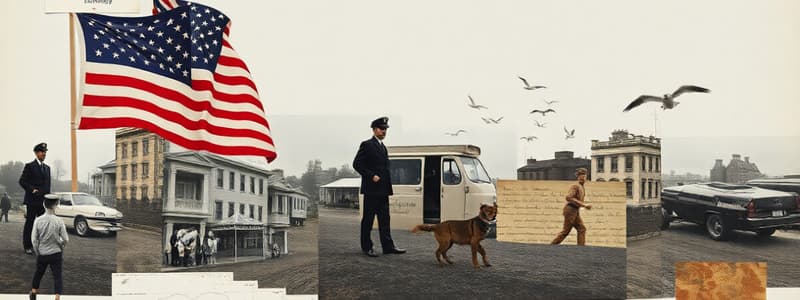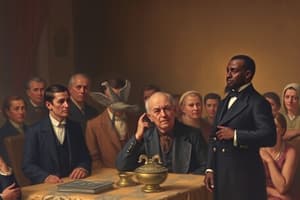Podcast
Questions and Answers
What was the primary criterion established by the U.S. Congress in 1790 for determining eligibility for naturalized citizenship?
What was the primary criterion established by the U.S. Congress in 1790 for determining eligibility for naturalized citizenship?
- Possession of property and a demonstrated understanding of American laws.
- Being a 'free white person' who had migrated to the United States. (correct)
- Proficiency in English and a commitment to uphold the Constitution.
- Having resided in the United States for a minimum of five years and demonstrating good moral character.
According to the content, how did the arrival of diverse immigrants from Europe influence the existing racial classifications in America?
According to the content, how did the arrival of diverse immigrants from Europe influence the existing racial classifications in America?
- It prompted a re-evaluation of whiteness, leading to a more politicized and restrictive view of how it was allocated among European groups. (correct)
- It reinforced the original definition of whiteness, leading to stricter enforcement of immigration laws against non-white populations.
- It led to a swift expansion of the definition of whiteness to include all European immigrants, regardless of their cultural background.
- It caused a widespread acceptance of racial diversity and the abandonment of racial classifications.
In the early 20th century, how did American society often categorize European immigrants in relation to the concept of 'whiteness'?
In the early 20th century, how did American society often categorize European immigrants in relation to the concept of 'whiteness'?
- All European immigrants were immediately and uniformly accepted as 'white' without any discrimination.
- European immigrants were ranked differently, with some considered 'whiter' and more worthy of citizenship than others. (correct)
- European immigrants were primarily evaluated based on their economic contributions rather than their racial identity.
- European immigrants were largely excluded from discussions of 'whiteness' and considered a separate racial category.
How did The Times portray Italian immigrants seeking vaccinations in an 1874 story?
How did The Times portray Italian immigrants seeking vaccinations in an 1874 story?
What factors contributed to the shifting and politicized understanding of 'whiteness' in America during the late 19th and early 20th centuries?
What factors contributed to the shifting and politicized understanding of 'whiteness' in America during the late 19th and early 20th centuries?
Which phrase did The Times use in an 1880 story to describe immigrants, including Italians?
Which phrase did The Times use in an 1880 story to describe immigrants, including Italians?
According to Matthew Frye Jacobson's research, how did the surge of culturally diverse immigrants from Europe affect the American perception of whiteness?
According to Matthew Frye Jacobson's research, how did the surge of culturally diverse immigrants from Europe affect the American perception of whiteness?
What role did journalists, politicians, and social scientists play in the evolving definition of 'whiteness' during the immigration waves?
What role did journalists, politicians, and social scientists play in the evolving definition of 'whiteness' during the immigration waves?
In an 1882 editorial titled "Our Future Citizens," how did The Times characterize Southern Italian immigrant children?
In an 1882 editorial titled "Our Future Citizens," how did The Times characterize Southern Italian immigrant children?
How did the racist myth described contribute to the portrayal of the lynching victim "Dago Joe" in an 1887 Times story?
How did the racist myth described contribute to the portrayal of the lynching victim "Dago Joe" in an 1887 Times story?
What differentiated Matthew Frye Jacobson's perspective on whiteness from earlier views?
What differentiated Matthew Frye Jacobson's perspective on whiteness from earlier views?
What underlying belief is reflected in The Times's description of Italian immigrants as "links in a descending chain of evolution?"
What underlying belief is reflected in The Times's description of Italian immigrants as "links in a descending chain of evolution?"
Which statement below best describes the relationship between race and eligibility for citizenship in the early United States, based on the content?
Which statement below best describes the relationship between race and eligibility for citizenship in the early United States, based on the content?
How does the use of the slur "dago" in the 1887 Times story reveal the broader societal attitudes towards Italian immigrants?
How does the use of the slur "dago" in the 1887 Times story reveal the broader societal attitudes towards Italian immigrants?
Based on the content, which factor most significantly shaped the negative stereotypes of Italian immigrants in the Northern press during the late 19th century?
Based on the content, which factor most significantly shaped the negative stereotypes of Italian immigrants in the Northern press during the late 19th century?
Which of the following best describes the New York Times editorial's stance on the lynching of Italian-Americans in 1891?
Which of the following best describes the New York Times editorial's stance on the lynching of Italian-Americans in 1891?
How did the characterization of Italian immigrant children in the "Our Future Citizens" editorial serve to reinforce existing prejudices?
How did the characterization of Italian immigrant children in the "Our Future Citizens" editorial serve to reinforce existing prejudices?
What action did the Italian government take in response to the lynching of its citizens in New Orleans?
What action did the Italian government take in response to the lynching of its citizens in New Orleans?
How did President Harrison respond to the Italian government's demands following the lynching incident?
How did President Harrison respond to the Italian government's demands following the lynching incident?
What was the significance of President Harrison's 1892 Columbus Day proclamation for Italian-Americans?
What was the significance of President Harrison's 1892 Columbus Day proclamation for Italian-Americans?
According to Danielle Battisti, how did Italian-Americans rewrite history in relation to Christopher Columbus?
According to Danielle Battisti, how did Italian-Americans rewrite history in relation to Christopher Columbus?
What is the central irony regarding the protection that President Harrison advocated for in his 1891 State of the Union address?
What is the central irony regarding the protection that President Harrison advocated for in his 1891 State of the Union address?
Which of the following statements accurately reflects the New York Times's description of the lynched Italian-Americans?
Which of the following statements accurately reflects the New York Times's description of the lynched Italian-Americans?
The New York Times editorial used what comparison to describe the lynched Italian-Americans?
The New York Times editorial used what comparison to describe the lynched Italian-Americans?
What was a common practice among Southern newspapers regarding lynchings of African-Americans during the late 19th and early 20th centuries?
What was a common practice among Southern newspapers regarding lynchings of African-Americans during the late 19th and early 20th centuries?
How did some news organizations, including The Times, legitimize lynching, even if they claimed to oppose it?
How did some news organizations, including The Times, legitimize lynching, even if they claimed to oppose it?
What role did fabricated accusations of sexual assault play in the lynchings of Black men in the South?
What role did fabricated accusations of sexual assault play in the lynchings of Black men in the South?
What was The Times' initial reaction to Ida B. Wells' reporting on the use of rape allegations against Black men?
What was The Times' initial reaction to Ida B. Wells' reporting on the use of rape allegations against Black men?
The use of terms like "brute" and "fiend" by newspapers when referring to Black men who were lynched served primarily to:
The use of terms like "brute" and "fiend" by newspapers when referring to Black men who were lynched served primarily to:
How did the coverage of lynchings in Northern newspapers compare to that in Southern newspapers, according to Mr Seguin?
How did the coverage of lynchings in Northern newspapers compare to that in Southern newspapers, according to Mr Seguin?
What does the phrase "a thread bare lie" refer to in the context of the text?
What does the phrase "a thread bare lie" refer to in the context of the text?
What might constitute a 'minor violation of the social code' that could lead to a rape charge against a Black man, according to the Equal Justice Initiative?
What might constitute a 'minor violation of the social code' that could lead to a rape charge against a Black man, according to the Equal Justice Initiative?
How did the mythologizing of Columbus impact Italian-Americans in the United States?
How did the mythologizing of Columbus impact Italian-Americans in the United States?
What was Henry Cabot Lodge's primary argument concerning the lynching in New Orleans?
What was Henry Cabot Lodge's primary argument concerning the lynching in New Orleans?
How did the racist immigration restrictions of the 1920s contradict the legal status of Italians in America?
How did the racist immigration restrictions of the 1920s contradict the legal status of Italians in America?
In what way did Italian-Americans leverage the 'romantic fictions' surrounding Columbus?
In what way did Italian-Americans leverage the 'romantic fictions' surrounding Columbus?
What is the key takeaway regarding racial categories from the Italian-American experience described?
What is the key takeaway regarding racial categories from the Italian-American experience described?
If a future article about Columbus contains an error discovered after publication, what action would The New York Times likely take?
If a future article about Columbus contains an error discovered after publication, what action would The New York Times likely take?
What is the primary purpose of providing 'Site Information Navigation' links at the end of an article on The New York Times website?
What is the primary purpose of providing 'Site Information Navigation' links at the end of an article on The New York Times website?
In the context of the provided text, what is the purpose of the 'Share full article' button?
In the context of the provided text, what is the purpose of the 'Share full article' button?
Why might The New York Times include an 'Advertisement' section within or alongside an article?
Why might The New York Times include an 'Advertisement' section within or alongside an article?
How does The New York Times address a factual error in a previously published article?
How does The New York Times address a factual error in a previously published article?
What is the most likely reason The New York Times provides links to sections such as 'Privacy Policy' and 'Terms of Service' at the bottom of its articles?
What is the most likely reason The New York Times provides links to sections such as 'Privacy Policy' and 'Terms of Service' at the bottom of its articles?
What is one implication of The New York Times having a 'Site Map' link?
What is one implication of The New York Times having a 'Site Map' link?
What can be inferred about The New York Times' approach to user engagement based on the presence of a comment section?
What can be inferred about The New York Times' approach to user engagement based on the presence of a comment section?
Why does The New York Times include a copyright notice at the bottom of its website?
Why does The New York Times include a copyright notice at the bottom of its website?
What is the purpose of the 'Manage Privacy Preferences' link found in the 'Site Information Navigation' section?
What is the purpose of the 'Manage Privacy Preferences' link found in the 'Site Information Navigation' section?
What was the initial target of violence at the start of the New York City Draft Riots on July 13, 1863?
What was the initial target of violence at the start of the New York City Draft Riots on July 13, 1863?
How did the focus of the New York City Draft Riots shift after the initial outbreak of violence?
How did the focus of the New York City Draft Riots shift after the initial outbreak of violence?
What specific motivation is attributed to Irish-American longshoremen, pavers, cart men, and hack drivers in their attacks during the New York City Draft Riots?
What specific motivation is attributed to Irish-American longshoremen, pavers, cart men, and hack drivers in their attacks during the New York City Draft Riots?
How did the New York Times and Horace Greeley's Tribune depict the composition of the mob involved in the New York City Draft Riots?
How did the New York Times and Horace Greeley's Tribune depict the composition of the mob involved in the New York City Draft Riots?
What underlying sentiment does New York lawyer George Templeton Strong express in his diary regarding the Irish immigrants involved in the draft riots?
What underlying sentiment does New York lawyer George Templeton Strong express in his diary regarding the Irish immigrants involved in the draft riots?
What does the phrase 'No wonder St.Patrick drove all the venomous vermin out of Ireland!' imply about Strong's perspective?
What does the phrase 'No wonder St.Patrick drove all the venomous vermin out of Ireland!' imply about Strong's perspective?
What does the passage suggest about the perspective of Irish-American soldiers serving in the Union Army towards the draft rioters?
What does the passage suggest about the perspective of Irish-American soldiers serving in the Union Army towards the draft rioters?
What conclusion can be derived from examining the events and aftermath of the New York Draft Riots?
What conclusion can be derived from examining the events and aftermath of the New York Draft Riots?
What was the primary concern of Irish-American soldiers regarding the draft riots in relation to the Union war effort?
What was the primary concern of Irish-American soldiers regarding the draft riots in relation to the Union war effort?
How did Edmund O'Dwyer, an Irish-American soldier, justify the federal government's right to conscript citizens?
How did Edmund O'Dwyer, an Irish-American soldier, justify the federal government's right to conscript citizens?
What was the significance of the rioters' targeting of Colonel Robert Nugent's home?
What was the significance of the rioters' targeting of Colonel Robert Nugent's home?
In what way did the experiences of Colonels Nugent and O'Brien provide a broader insight into Irish-American perspectives during the draft riots?
In what way did the experiences of Colonels Nugent and O'Brien provide a broader insight into Irish-American perspectives during the draft riots?
What motivated Michael Donlon, an Irish-born soldier, to urge his family to 'enforce the draft'?
What motivated Michael Donlon, an Irish-born soldier, to urge his family to 'enforce the draft'?
How did the 69th New York regiment respond upon learning that 'citizens of Irish birth' were responsible for the riots?
How did the 69th New York regiment respond upon learning that 'citizens of Irish birth' were responsible for the riots?
What was the ultimate fate of Colonel Henry O'Brien during the New York City Draft Riots?
What was the ultimate fate of Colonel Henry O'Brien during the New York City Draft Riots?
What action prevented the rioters from further desecrating Colonel O'Brien's body after his death?
What action prevented the rioters from further desecrating Colonel O'Brien's body after his death?
What did Peter Welsh of the Irish-American 28th Massachusetts believe would be achieved through a unanimous war effort, and how did the draft riots impact this belief?
What did Peter Welsh of the Irish-American 28th Massachusetts believe would be achieved through a unanimous war effort, and how did the draft riots impact this belief?
How did the draft riots contribute to dividing Irish immigrants during the Civil War era?
How did the draft riots contribute to dividing Irish immigrants during the Civil War era?
Flashcards
1790 Citizenship Law
1790 Citizenship Law
In 1790, Congress restricted citizenship to 'free white persons'.
European Immigration Waves
European Immigration Waves
Massive influx of immigrants from all over Europe.
"Whiteness of a Different Color"
"Whiteness of a Different Color"
A book that explores how different groups of Europeans were classified in America.
National Panic (Immigration)
National Panic (Immigration)
Signup and view all the flashcards
Racializing Europeans
Racializing Europeans
Signup and view all the flashcards
Italian-American Experience
Italian-American Experience
Signup and view all the flashcards
"Races"
"Races"
Signup and view all the flashcards
Racial Redemption
Racial Redemption
Signup and view all the flashcards
Mythologizing of Italian-Americans
Mythologizing of Italian-Americans
Signup and view all the flashcards
New Orleans Lynching (late 19th century)
New Orleans Lynching (late 19th century)
Signup and view all the flashcards
Henry Cabot Lodge's Argument
Henry Cabot Lodge's Argument
Signup and view all the flashcards
Immigration Restrictions (1920s)
Immigration Restrictions (1920s)
Signup and view all the flashcards
1965 Immigration Act
1965 Immigration Act
Signup and view all the flashcards
"Dago"
"Dago"
Signup and view all the flashcards
Little Palermo
Little Palermo
Signup and view all the flashcards
Italian Immigrant Stereotypes (1870s)
Italian Immigrant Stereotypes (1870s)
Signup and view all the flashcards
Traditional Brigand of the Abruzzi
Traditional Brigand of the Abruzzi
Signup and view all the flashcards
"Links in a descending chain of evolution"
"Links in a descending chain of evolution"
Signup and view all the flashcards
"Low and ignorant"
"Low and ignorant"
Signup and view all the flashcards
"Ragged, filthy, and verminous"
"Ragged, filthy, and verminous"
Signup and view all the flashcards
African-Americans and Sicilians
African-Americans and Sicilians
Signup and view all the flashcards
Racialized Lynching Coverage
Racialized Lynching Coverage
Signup and view all the flashcards
"Brute" and Other Labels
"Brute" and Other Labels
Signup and view all the flashcards
Complicity of Northern Newspapers
Complicity of Northern Newspapers
Signup and view all the flashcards
Fabricated Rape Charges
Fabricated Rape Charges
Signup and view all the flashcards
Social Code Violations
Social Code Violations
Signup and view all the flashcards
NY Times's treatment of Ida B. Wells
NY Times's treatment of Ida B. Wells
Signup and view all the flashcards
Presumption of Guilt
Presumption of Guilt
Signup and view all the flashcards
Threadbare Lies
Threadbare Lies
Signup and view all the flashcards
Scabrous Times Editorial (1891)
Scabrous Times Editorial (1891)
Signup and view all the flashcards
Dehumanizing Stereotypes
Dehumanizing Stereotypes
Signup and view all the flashcards
Italian Government's Reaction
Italian Government's Reaction
Signup and view all the flashcards
Harrison's Response
Harrison's Response
Signup and view all the flashcards
Columbus Day Proclamation (1892)
Columbus Day Proclamation (1892)
Signup and view all the flashcards
"First Immigrant" Myth
"First Immigrant" Myth
Signup and view all the flashcards
Columbus's Actual Voyage
Columbus's Actual Voyage
Signup and view all the flashcards
Rewriting History
Rewriting History
Signup and view all the flashcards
Privacy Policy
Privacy Policy
Signup and view all the flashcards
Terms of Service
Terms of Service
Signup and view all the flashcards
Terms of Sale
Terms of Sale
Signup and view all the flashcards
Site Map
Site Map
Signup and view all the flashcards
Contact Us
Contact Us
Signup and view all the flashcards
Accessibility
Accessibility
Signup and view all the flashcards
Copyright notice
Copyright notice
Signup and view all the flashcards
Ad Choices
Ad Choices
Signup and view all the flashcards
Manage Privacy Preferences
Manage Privacy Preferences
Signup and view all the flashcards
Subscriptions
Subscriptions
Signup and view all the flashcards
NYC Draft Riots (1863)
NYC Draft Riots (1863)
Signup and view all the flashcards
Monolithic View
Monolithic View
Signup and view all the flashcards
Rioters' Targets
Rioters' Targets
Signup and view all the flashcards
Irish-American Rioters
Irish-American Rioters
Signup and view all the flashcards
Draft Riot Aftermath
Draft Riot Aftermath
Signup and view all the flashcards
Initial Blame
Initial Blame
Signup and view all the flashcards
George Templeton Strong
George Templeton Strong
Signup and view all the flashcards
Union Soldiers' View
Union Soldiers' View
Signup and view all the flashcards
Soldiers' View of Draft Riots
Soldiers' View of Draft Riots
Signup and view all the flashcards
Legality of Conscription
Legality of Conscription
Signup and view all the flashcards
Col. Robert Nugent's Ordeal
Col. Robert Nugent's Ordeal
Signup and view all the flashcards
Col. Henry O'Brien's Fate
Col. Henry O'Brien's Fate
Signup and view all the flashcards
69th NY Regiment's Reaction
69th NY Regiment's Reaction
Signup and view all the flashcards
9th Massachusetts' Stance
9th Massachusetts' Stance
Signup and view all the flashcards
John O'Brien's View
John O'Brien's View
Signup and view all the flashcards
Timing of Draft Riots
Timing of Draft Riots
Signup and view all the flashcards
Irish-American Soldiers
Irish-American Soldiers
Signup and view all the flashcards
Division Among Immigrants
Division Among Immigrants
Signup and view all the flashcards




